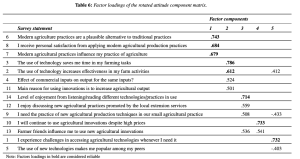How the use of mixed-method and multi-disciplines helped the researchers get a better understanding of the attitudes and perceptions of the adoption of agricultural innovations in Kakamega County, Kenya.
In Kenya, the agricultural sector is crucial to eradicating food insecurity, lowering poverty levels, and boosting the national economy. This is because the small-scale agricultural output contributes disproportionately to the Kenyan economy, constituting 21% of the country’s gross domestic product (GDP) and employing 56% of all workers. Thus, the adoption of technology is essential for increasing crop yields and bolstering overall agricultural growth for economic growth in Kenya. Nonetheless, the adoption of new farming products and tools has been low despite prior marketing efforts.
Nyairo, Pfeiffer, Spaulding & Russel (2022) aim to unravel the possible cause of the lack of adoption of agricultural innovations among smallholder farmers in Kakamega County, Kenya. In doing so, they focused on the attitudes and perceptions of these farmers. Attitude is a tendency to react favourably or unfavourably towards an object, guided by an individual's emotions and perceptions. Perception is the impression of benefits of the innovation, adaptive experiences, or perceived difficulty in the implementation of the technology. The perception is also influenced by the socio-economic factors; gender of the farmer, level of education; cost of inputs; and lack of complementary inputs which were included in their analysis to provide a holistic understanding. This research is interdisciplinary as it combines the disciplines of agriculture, social psychology, and socioeconomics to investigate this niche issue.
Furthermore, the research uses an exploratory sequential mixed methods design to disclose the attitudes and perceptions of the smallholder farmers. Exploratory meant that the participants were unaware of what the study was about. Sequential mixed methods mean that the study made use of both quantitative and qualitative methods, one after the other. The study first conducted a survey questionnaire for 245 small-holder farm households across seven sub-counties of Kakamega. The survey consists of 63 sequential, open- and close-ended questions. The questions ranged from probing the socio-economic characteristics of the households to their attitudes and perceptions of new technologies. Participants, who had indicated in the survey their willingness to take part in the focus group, were purposefully selected to represent the variety of age groups, genders, and farming experiences included in the survey. This led to four focus groups from four of the twelve sub-counties of Kakamega. The focus group was facilitated by one of the authors, Newto Morara Nyairo, who has a good command of the local language and customs. Participants were interviewed on their attitudes and perceptions of agricultural technology, agricultural extension, and their views toward the primary channels of agricultural information. The combination of the survey results followed by the focus groups was thought to deepen and broaden the knowledge of the points of view of smallholder farmers on their adoption of new agricultural technologies.
To analyse the aggregate collected data, the study uses principal component analysis (PCA) for the qualitative data and thematic analysis for the qualitative data. Table 6 shows the result of the PCA with the principal statements retrieved and how often they were felt by participants. Table 7 shows the reliability test to see whether the correlations are reliable, which they are for exploratory research. 

Using an interdisciplinary and mixed methods approach, the research was able to find that small-holder farmers in Kenya are not well equipped to use new technologies as they have limited access to agricultural information and training. This access was further vulnerable to the lack of trust between farmers and the extension agents. Such findings could help improve the use of innovative agricultural technologies, which would increase agricultural outputs and Kenya’s economy with.
Source: Nyairo, N. M., Pfeiffer, L., Spaulding, A., & Russell, M. (2022). Farmers' attitudes and perceptions of adoption of agricultural innovations in Kenya: a mixed methods analysis. Journal of Agricultural and Rural Development in the Tropics and Subtropics, 123(1), 147-160. Doi: 10.1710/kobra-202204216055


